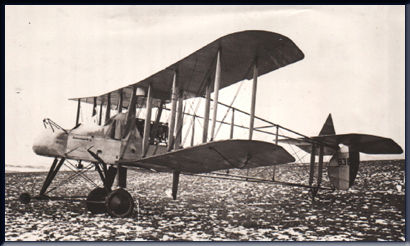

Commonwealth War Graves in Iraq
WW1 Aviation & 6 Squadron RAF
During the years of WW1, if you count every variant, 6 Squadron operated twenty four different types of aircraft! Quite an achievement over the relatively short period of four years, when new aircraft were constantly being developed in order to keep up with the technological advances made by the German air force.
In the RAF these days, where most squadrons fly a single type - in the case of 6 Squadron the Eurofighter Typhoon - it is hard to imagine a single squadron flying fighters, bombers and reconnaissance aircraft all at the same time on a wide variety of missions. It was only when 6 Squadron was re-equiped with the Royal Aircraft Factory RE8 reconnaissance / bomber (this took place during the months of March and April 1917) that the squadron finally had on charge a single type of aircraft. Since then, the squadron has mostly maintained a single type philosophy, with two or three exceptions during the thirties and forties where it had two or three types of aircraft on charge at the same time.
6 Squadron Aircraft (1914 - 1918)

Maurice Farman MF7 "Longhorn". The Longhorn was only flown by 6 Squadron in England, prior to the squadron being deployed to the Western Front on the 7th October 1914.

The early model BE2 (as opposed to the later variants) was only flown by 6 Squadron in England, prior to the squadron being deployed to the Western Front on the 7th October 1914 Length: 28' 4", Wingspan: 38' 8", Speed: 72.5 mph, Engine: 70 hp Renault V-8

Maurice Farman MF11 "Shorthorn". The Shorthorn was only flown by 6 Squadron in England, prior to the squadron being deployed to the Western Front on the 7th October 1914. Length: 32' 4", Wingspan: 53' 5 1/4", Speed: 53 mph, Engine: 80 hp Renault V-inline

This RE1, one of only two RE1s built, was flown by 6 Squadron before the squadron went to France on 07/10/1914. It was used as a prototype, with changes progressively made to reduce weight as well as improve stability and manoeuvrability (ailerons instead of wing warping and increased dihedral etc) – changes that would later be incorporated into the BE2c.

The RE5 was only flown by 6 Squadron in England, prior to the squadron being deployed to the Western Front on the 7th October 1914

This is a photo of an actual BE8 flown by 6 Squadron. Length: 27' 4 1/4", Wingspan: 37' 8", Speed: 70 mph, Engine: 80 hp Gnome Rotary

Henry Farman F20 Length: 26' 9", Wingspan: 44' 6", Speed: 65 mph, Engine: 80 hp Gnome Rotary Monosoupape

Royal Aircraft Factory BE2a Length: 28' 4", Wingspan: 36' 11 1/8", Speed: 74 mph, Engine: 70 hp Renault V-8

Bleriot XI-2 Length: 27' 10", Wingspan: 33' 11", Speed: 66 mph, Engine: 70 hp Gnome Rotary

Martinsyde S1 Length: 21' 0", Wingspan: 27' 8", Speed: 84 mph, Engine: 80 hp Gnome Rotary

Royal Aircraft Factory BE2c Length: 27' 3", Wingspan: 37' 0", Speed: 86 mph, Engine: 90 hp RAF 1a V-8

Royal Aircraft Factory FE2a. This actual aircraft was flown by 6 Squadron, the photograph taken at the squadron's aerodrome at Abeele. Length: 32' 3", Wingspan: 47' 9"", Speed: 80 mph, Engine: 120 hp Beardmore 6 Cyl

Bristol Scout C Length: 20' 8", Wingspan: 24' 7", Speed: 100 mph, Engine: 90 hp Le Rhone 9 Cyl Rotary

Martinsyde G100 "Elephant", used by 6 Squadron for field evaluation. Length: 26' 6", Wingspan: 38' 0", Speed: 104 mph, Engine: 120 hp Beardmore 6 Cyl

Royal Aircraft Factory FE2b. Length: 32' 3", Wingspan: 47' 9", Speed: 80 mph, Engine: 120 hp or 160 hp Beardmore 6 Cyl

Royal Aircraft Factory BE2e. The BE2e was similar to the BE2f (which used a BE2c fuselage) and the BE2g (which used a BE2d fuselage). Length: 27' 3", Wingspan: 40' 6", Speed: 90 mph, Engine: 90 hp RAF 1a V-8

Royal Aircraft Factory RE8 Length: 27' 10 1/2", Wingspan: 42' 7" (upper), 32' 7 1/2" (lower), Speed: 103 mph, Engine: 140 hp RAF 4a V-12